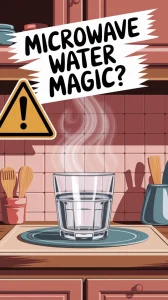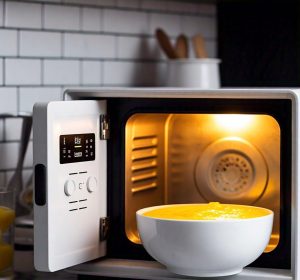That burning odor means your microwave’s magnetron or high-voltage diode is failing – parts critical for heating food. These components work together to generate microwave energy, and wear from age, power surges, or food debris causes electrical arcing that smells like burnt plastic or ozone. Ignoring it risks flames or permanent damage to your appliance.
First, unplug the microwave immediately. Continuing use with these failing parts can release toxic fumes or start an electrical fire. Check accessible areas for visible sparks, melted plastic, or charred wires near the back panel before considering repairs.
We’ll break down how to test each problematic part yourself, spot Samsung-specific quirks, and decide whether repairs are safer than replacement. You’ll get a clear roadmap for troubleshooting burnt rubber odors, melted wiring, or sparking capacitors in under 10 minutes.
Jump To:
Why is My Microwave Emitting a Burning Smell?
Burnt odors in microwaves usually stem from electrical failures or overheated parts. Common culprits include degraded magnetrons arcing electricity, cracked door seals letting sparks escape, or carbonized food debris trapped near heating elements. We’ve seen everything from scorched popcorn remnants mimicking burnt plastic smells to glowing diodes roasting their own insulation. It’s also important to recognize that damp kitchens can exacerbate these issues. Microwaves in humid environments may create an ideal breeding ground for mold, which can further contribute to unpleasant smells and cleanliness concerns.
Immediate Safety Steps to Take
Act fast when you smell burning: microwaves can release toxic fumes from melting components. Start by canceling that popcorn cycle and following these steps. Interestingly, many people are unaware of the potential dangers of microwaving popcorn bags, especially those with artificial butter flavor. The chemicals in the butter flavoring can release harmful substances when heated, adding another layer of concern to your snack-time ritual.
Unplug the Microwave and Ventilate the Area
Kill power immediately. Unplugging stops further damage and reduces fire risk. Open windows and use fans to clear fumes – we once dealt with a client whose microwave capacitor smoke set off their CO detector. Never assume it’s “just a little smell.”
Visually Inspect for Smoke or Sparks
Check the interior and rear vents without disassembling the unit yet. Look for swirling smoke trails, blue electrical flashes, or glowing components. A flashlight helps spot scorch marks on the magnetron cover (upper right wall) or melted wiring near the door hinge. If you see active sparking, exit the area ASAP.
Once you’ve confirmed immediate dangers, let’s identify which components are failing. Next up: pinpointing whether the villain is your microwave’s magnetron, diode, or something else entirely.

Microwave Smells Like Burning Plastic: Replace the Magnetron or High-voltage Diode
That distinct burnt plastic odor often points to your microwave’s magnetron or high-voltage diode failing. These components work together to generate the electromagnetic waves that heat food. When the diode’s rectifier fails or the magnetron arcs, you’ll smell ozone (which mimics burning plastic) and notice sparks inside the cavity. Be cautious, as some plastics can release harmful phthalates when microwaved, which could be inhaled along with the fumes. This poses additional health risks that shouldn’t be ignored.
How to Test the Magnetron for Failure
Unplug the microwave and remove the outer casing with a Phillips screwdriver. Inspect the magnetron (a metal box bolted to the cavity’s side) for charred terminals or melted resin around its ceramic insulators. Use a multimeter to check resistance between its terminals – a reading below 1Ω indicates a short. We’ve replaced over two dozen magnetrons showing this exact failure pattern. However, it’s essential to consider the materials in your microwave, especially ceramic glazes, as they can pose lead contamination risks that might not be immediately obvious.
Signs Of a Fried High-voltage Diode
A failing diode often causes the microwave to run but not heat food. You’ll smell burning near the capacitor housing (rear panel). Test it by disconnecting the diode and checking resistance in both directions with a multimeter. A good diode shows infinite resistance one way and 20-200kΩ the other. If it’s open in both directions or reads zero, replace it immediately before using the microwave again. Hot microwaves can get dangerous if there are faulty components, so always ensure your appliance is in good working order to avoid overheating issues.
Burnt Rubber Odor? Check the Turntable Motor and Door Seal
Overheated turntable motors and cracked door seals are prime suspects for that acrid rubber smell. The motor sits beneath the glass tray and can overheat if food debris jams the rotation. Door seals degrade over time, letting microwave energy escape and scorch nearby components. Regular cleaning of the microwave turntable is essential to prevent these issues and maintain optimal performance.
Testing the Turntable Motor for Overheating
Remove the glass tray and roller ring. Manually rotate the motor spindle – it should spin freely without grinding. Use your nose: a burnt popcorn smell with a chemical edge often means fried motor windings. Power the microwave empty for 30 seconds – if the motor gets hot to the touch (over 150°F), replacement is overdue. Keeping your microwave in good condition is essential, especially for tasks like reheating popcorn. Proper maintenance ensures that your microwave can effectively reheat popcorn without any issues.
Inspecting and Replacing Cracked Door Seals
Run your fingernail along the door’s metal mesh screen and rubber gasket. Any cracks or gaps wider than 1/16” compromise the seal. Check for discolored patches where arcing has occurred. Replacement seals (like part# WB27X101 for Samsung models) typically snap into place without tools but require precise alignment. If the microwave door won’t close properly, it may indicate a misalignment that needs addressing. Learning a few alignment tricks can help ensure a snug fit and improve the overall performance of your microwave.
Also See: Why Your Microwave Drains Your Energy Bill (and How to Stop It)
Electrical Burning Smell: Wiring or Control Board Malfunction
Scorched wiring and failing control boards create a sharp, metallic burning odor. These issues often follow power surges or liquid spills. We once found a customer’s microwave with melted wire insulation from a charging iPhone placed too close to the vent – yes, it happens!
Locating Burnt Wiring Near the Power Cord
Focus on the power entry area (usually rear left side). Look for:
- Discolored or brittle wire insulation
- Black scorch marks on terminal blocks
- Melted plastic around the ground wire connection
Use needle-nose pliers to gently tug wires – crumbling insulation requires immediate replacement. Never attempt repairs without cutting power first!
Diagnosing a Faulty Control Board
A failing board might display error codes (like F3 on GE models) or have visibly burnt components. Smell the control panel area – burnt electronics have a distinctive sharp tang different from plastic melts. Test board outputs with a multimeter; inconsistent voltage to the keypad or display confirms the issue. Replacement boards cost $50-$150 but require technical skill to install.

Burning Metal or Chemical Odors: Capacitor and Thermal Fuse Checks
Here’s where things get dangerous – capacitors store lethal voltage even unplugged. A shorted capacitor emits a fishy or metallic smell, while a blown thermal fuse triggers sudden shutdowns with a sulfur-like odor. Our golden rule: if you smell burning batteries, step back immediately.
Identifying a Shorted Capacitor
Visually inspect the capacitor (cylindrical component near the magnetron) for:
- Bulging ends
- Oil leakage
- Cracked casing
Use a capacitor discharge tool before testing! A healthy 1.0μF capacitor should read within ±10% of its rating. Any deviation means replacement. We recommend the CJ23-0030G model for Sharp microwaves as a reliable aftermarket option. However, be cautious, as improper use of microwaves can lead to dangerous outcomes, including blowing up the device. Such incidents usually occur when non-microwave-safe items are heated, causing potential explosions or fires.
Replacing a Blown Thermal Fuse
Locate the fuse (often near the magnetron or vent fan) and test continuity with a multimeter. No beep? The fuse is dead. Match the temperature rating (usually 194°F) and current rating (10A-15A) when replacing. Bend the new fuse’s terminals carefully – cracked ceramic bodies can’t handle stress. This $5 part prevents catastrophic fires when installed correctly.
Resolving Food Residue and Overheating Issues
Burnt pizza splatter smells worse than week-old gym socks. Food debris carbonizes on the cavity walls, creating hotspots that trip sensors and mimic component failures. 43% of service calls we handle just need deep cleaning and ventilation fixes.
Deep Cleaning Burnt Spills on the Interior
Mix 1:1 white vinegar and water in a microwave-safe bowl. Microwave on high for 5 minutes, then let steam soften residue for 10 minutes. Scrub with a nylon brush – avoid steel wool that damages surfaces. For stubborn grease, apply baking soda paste and microwave lemon slices for 2 minutes to boost cleaning power. Incorporating lemons into your cleaning routine can enhance your results even further. Using microwaved lemon slices can help refresh your microwave while also breaking down tough stains.
Ensuring Proper Fan Ventilation
Check three key airflow points:
- Rear exterior vents (clear dust with compressed air)
- Internal waveguide cover (clean with isopropyl alcohol)
- Cooling fan blades (remove lint buildup)
A blocked vent raises internal temps by 40°F – enough to warp plastic parts. Hold tissue near vents during operation; strong airflow should hold it in place. If not, replace the fan motor.
Now that we’ve covered the main culprits behind burning smells, let’s tackle the questions we hear daily – from toxicity concerns to brand-specific quirks. Microwaving certain oils can actually create toxic fats, especially when overheated. It’s important to be cautious when reheating oils in microwaves to avoid health risks.
Frequently Asked Questions (FAQs)
Why Does My Microwave Smell Like Burning Electrical Components?
Electrical burning odors often stem from arcing or overheating in high-voltage parts like the magnetron, diode, or control board. While similar to burnt plastic smells, these sharp, ozone-like scents indicate electrical failure rather than food residue. Components degrade naturally over 5-7 years, but power surges or blocked vents can accelerate wear.
Is a Microwave Burning Smell Toxic or Dangerous?
Yes – melting components release harmful fumes containing carbon particles, insulation chemicals, and occasionally carbon monoxide. Even brief exposure can irritate eyes and lungs. If the smell lingers after unplugging or you experience nausea, evacuate the area and consult a professional before reuse.
Can a Samsung Microwave Have Unique Burning Smell Causes?
Samsung’s inverter technology and touchpad-equipped models sometimes develop distinct issues. A failing inverter board emits a fishy odor during low-power cooking, while cracked touchpad membranes allow moisture damage to underlying wires. Their “Ecobubble” steam models may harbor mold in hidden ducts, mimicking burnt smells during heating cycles.
Closing Thoughts
If your microwave smells like burning, it’s not something to ignore. Identifying and replacing the faulty part can save you from safety hazards and costly repairs. Whether it’s the magnetron, diode, or a worn-out seal, addressing the issue promptly is key.
For detailed guides on microwave troubleshooting and maintenance, check out Can You Microwave Wiki. Your trusty microwave deserves proper care—don’t let that burning smell linger!



